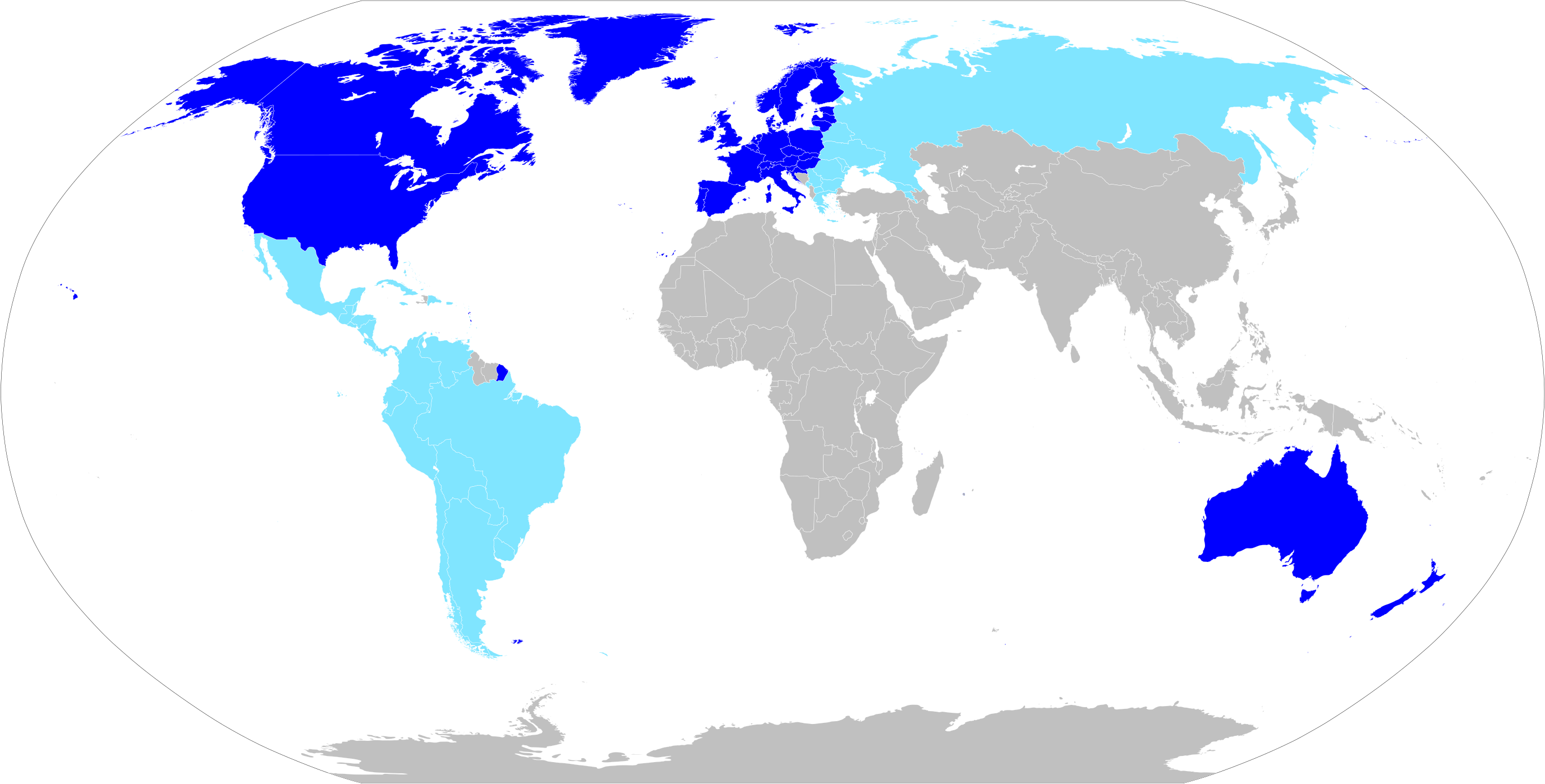|
Imagined Community
An imagined community is a concept developed by Benedict Anderson in his 1983 book '' Imagined Communities'' to analyze nationalism. Anderson depicts a nation as a socially-constructed community, imagined by the people who perceive themselves as part of a group. Anderson focuses on the way mass media, media creates imagined communities, especially the power of print media in shaping an individual's social psyche. Anderson analyzes the written word, a tool used by churches, authors, and media companies (notably books, newspapers, and magazines), as well as governmental tools such as the map, the census, and the museum. These tools were all built to target and define a mass audience in the public sphere through dominant images, ideologies, and language. Anderson explores the racist and colonial origins of these practices before explaining a general theory that demonstrates how contemporary governments and corporations can (and frequently do) utilize these same practices. These the ... [...More Info...] [...Related Items...] OR: [Wikipedia] [Google] [Baidu] [Amazon] |
Benedict Anderson
Benedict Richard O'Gorman Anderson (August 26, 1936 – December 13, 2015) was an Anglo-Irish political scientist and historian who lived and taught in the United States. Anderson is best known for his 1983 book ''Imagined Communities'', which explored the origins of nationalism. A polyglot with an interest in Southeast Asia, he was the Aaron L. Binenkorb Professor of International Studies, Government & Asian Studies at Cornell University. His work on the "Cornell Paper", which disputed the official story of Indonesia's 30 September Movement and the subsequent Indonesian mass killings of 1965–66, anti-Communist purges of 1965–1966, led to his expulsion from that country. He was the elder brother of the historian Perry Anderson. Biography Background Anderson was born on August 26, 1936, in Kunming, China, to an Irish and Anglo-Irish people, Anglo-Irish father and English mother. His father, James Carew O'Gorman Anderson, was an official with Chinese Maritime Customs. The f ... [...More Info...] [...Related Items...] OR: [Wikipedia] [Google] [Baidu] [Amazon] |
Modernist
Modernism was an early 20th-century movement in literature, visual arts, and music that emphasized experimentation, abstraction, and Subjectivity and objectivity (philosophy), subjective experience. Philosophy, politics, architecture, and social issues were all aspects of this movement. Modernism centered around beliefs in a "growing Marx's theory of alienation, alienation" from prevailing "morality, optimism, and Convention (norm), convention" and a desire to change how "social organization, human beings in a society interact and live together". The modernist movement emerged during the late 19th century in response to significant changes in Western culture, including secularization and the growing influence of science. It is characterized by a self-conscious rejection of tradition and the search for newer means of cultural expressions, cultural expression. Modernism was influenced by widespread technological innovation, industrialization, and urbanization, as well as the cul ... [...More Info...] [...Related Items...] OR: [Wikipedia] [Google] [Baidu] [Amazon] |
Invented Tradition
Invented traditions are cultural practices that are presented or perceived as traditional, arising from people starting in the distant past, but which are relatively recent and often consciously invented by historical actors. The concept was highlighted in the 1983 book ''The Invention of Tradition'', edited by Eric Hobsbawm and Terence Ranger. Hobsbawm's introduction argues that many "traditions" which "appear or claim to be old are often quite recent in origin and sometimes invented." This "invention" is distinguished from "starting" or "initiating" a tradition that does not then claim to be old. The phenomenon is particularly clear in the modern development of the nation and of nationalism, creating a national identity promoting national unity, and legitimising certain institutions or cultural practices. Background A set of practices, typically ritualistic or symbolic, aims to instill values and behavioral norms through repetition, such as saluting a flag before class. These p ... [...More Info...] [...Related Items...] OR: [Wikipedia] [Google] [Baidu] [Amazon] |
Entity Concept
In accounting, a business or an organization and its owners are treated as two separate parties. This is called the entity concept. The business stands apart from other organizations as a separate economic unit. It is necessary to record the business's transactions separately, to distinguish them from the owners' personal transactions. This helps to give a correct determination of the true financial condition of the business. This concept can be extended to accounting separately for the various divisions of a business in order to ascertain the financial results for each division. Under the business entity concept, a business holds separate entity and distinct from its owners. "The entity view holds the business 'enterprise to be an institution in its own right separate and distinct from the parties who furnish the funds" An example is a sole trader A sole proprietorship, also known as a sole tradership, individual entrepreneurship or proprietorship, is a type of enterprise own ... [...More Info...] [...Related Items...] OR: [Wikipedia] [Google] [Baidu] [Amazon] |
Western World
The Western world, also known as the West, primarily refers to various nations and state (polity), states in Western Europe, Northern America, and Australasia; with some debate as to whether those in Eastern Europe and Latin America also constitute the West. The Western world likewise is called the Occident () in contrast to the Eastern world known as the Orient (). Definitions of the "Western world" vary according to context and perspectives; the West is an evolving concept made up of cultural, political, and economic synergy among diverse groups of people, and not a rigid region with fixed borders and members. Some historians contend that a linear development of the West can be traced from Greco-Roman world, Ancient Greece and Rome, while others argue that such a projection constructs a false genealogy. A geographical concept of the West started to take shape in the 4th century CE when Constantine the Great, Constantine, the first Christian Roman emperor, divided the Roman Em ... [...More Info...] [...Related Items...] OR: [Wikipedia] [Google] [Baidu] [Amazon] |
Ballumbie
Ballumbie is a residential area on the north-east edge of Dundee, Scotland. The area was formerly an estate centred on Ballumbie Castle, a mid-16th-century fortification, which was followed by the 19th-century Ballumbie House. There is also a golf course surrounded by a medieval wall and the site of a late medieval parish church. The castle and house are located just outside the City of Dundee, in Angus. Ballumbie Castle Ballumbie Castle was built by the Lovell family. The Royal Commission on the Ancient and Historical Monuments of Scotland record the date of construction as 1545, although Historic Scotland give a date of 14th–15th century. The castle comprised a rectangular enclosure, approximately on a side, with round corner towers, overlooking the Fithie Burn. In the early 17th century it passed to the Maule family, who became Earls of Panmure in 1646. The castle was reported as being ruined by 1682, although the remaining east and south walls were later incorporated ... [...More Info...] [...Related Items...] OR: [Wikipedia] [Google] [Baidu] [Amazon] |
Sexual Orientation
Sexual orientation is an enduring personal pattern of romantic attraction or sexual attraction (or a combination of these) to persons of the opposite sex or gender, the same sex or gender, or to both sexes or more than one gender. Patterns are generally categorized under heterosexuality, homosexuality, and bisexuality, while asexuality (experiencing no sexual attraction to others) is sometimes identified as the fourth category. These categories are aspects of the more nuanced nature of sexual identity and terminology. For example, people may use other labels, such as '' pansexual'' or '' polysexual'', or none at all. According to the American Psychological Association, sexual orientation "also refers to a person's sense of identity based on those attractions, related behaviors, and membership in a community of others who share those attractions". ''Androphilia'' and ''gynephilia'' are terms used in behavioral science to describe sexual orientation as an alternative to a ... [...More Info...] [...Related Items...] OR: [Wikipedia] [Google] [Baidu] [Amazon] |
Community Of Interest
A community of interest, or interest-based community, is a community of people who share a common interest or passion. These people exchange ideas and thoughts about the given passion, but may know (or care) little about each other outside this area. Participation in a community of interest can be compelling, entertaining and create a community where people return frequently and remain for extended periods. Frequently, they cannot be easily defined by a particular geographical area. In other words, "a community of interest is a gathering of people assembled around a topic of common interest. Its members take part in the community to exchange information, to obtain answers to personal questions or problems, to improve their understanding of a subject, to share common passions or to play." In contrast to a spatial community, "a community of interest is defined not by space, but by some common bond (e.g. feeling of attachment) or entity (e.g. farming, church group)". Online communi ... [...More Info...] [...Related Items...] OR: [Wikipedia] [Google] [Baidu] [Amazon] |
Imagined Geographies
The concept of imagined geographies (or imaginative geographies) originated from Edward Said, particularly his work on critique on Orientalism. Imagined geographies refers to the perception of a space created through certain imagery, texts, and/or discourses. For Said, ''imagined'' does not mean to be false or made-up, but rather is used synonymous with ''perceived''. Despite often being constructed on a national level, imagined geographies also occur domestically in nations and locally within regions, cities, etc. Imagined geographies can be seen as a form of social constructionism on par with Benedict Anderson's concept of imagined communities. Edward Said's notion of Orientalism is tied to the tumultuous dynamics of contemporary history. Orientalism is often referred to as the West's patronizing perceptions and depictions of the East, but more specifically towards Islamic and Confucian states. Orientalism has also been labeled as the cornerstone of postcolonial studies. This ... [...More Info...] [...Related Items...] OR: [Wikipedia] [Google] [Baidu] [Amazon] |
Edward Said
Edward Wadie Said (1 November 1935 – 24 September 2003) was a Palestinian-American academic, literary critic, and political activist. As a professor of literature at Columbia University, he was among the founders of Postcolonialism, post-colonial studies.Robert Young, ''White Mythologies: Writing History and the West'', New York & London: Routledge, 1990. As a cultural critic, Said is best known for his book ''Orientalism (book), Orientalism'' (1978), a foundational text which critiques the Representation (arts), cultural representations that are the bases of Orientalism—how the Western world perceives the Orient. His model of textual analysis transformed the academic discourse of researchers in literary theory, literary criticism, and Middle Eastern studies.Stephen Howe"Dangerous mind?" ''New Humanist'', Vol. 123, November/December 2008. Born in Jerusalem, Mandatory Palestine, in 1935, Said was a Citizenship of the United States, United States citizen by way of his father ... [...More Info...] [...Related Items...] OR: [Wikipedia] [Google] [Baidu] [Amazon] |
Social Constructionism
Social constructionism is a term used in sociology, social ontology, and communication theory. The term can serve somewhat different functions in each field; however, the foundation of this Conceptual framework, theoretical framework suggests various facets of social reality—such as concepts, beliefs, Social norm, norms, and Value (ethics and social sciences), values—are formed through continuous interactions and negotiations among society's members, rather than Empirical research, empirical observation of Reality, physical reality. The theory of social constructionism posits that much of what individuals perceive as 'reality' is actually the outcome of a dynamic process of construction influenced by Convention (norm), social conventions and Social structure, structures. Unlike phenomena that are innately determined or biologically predetermined, these social constructs are collectively formulated, sustained, and shaped by the social environment, social contexts in which t ... [...More Info...] [...Related Items...] OR: [Wikipedia] [Google] [Baidu] [Amazon] |
Primordialists
Primordialism is the idea that nations or ethnic identities are fixed, natural, and ancient.Jack Hayward, Brian Barry, Archie Brown (2003) p 330 Primordialists argue that each individual has a single inborn ethnic identity independent of historical processes. While implicit primordialist assumptions are common in society and academic research, primordialism is widely rejected by scholars of nationalism and ethnicity, as individuals can have multiple ethnic identities which are changeable and socially constructed. Term The term primordialism is associated with sociologist Edward Shils and anthropologist Clifford Geertz. Shils was the first one who used this term in 1957 to describe the bonds between family members. The relations between family members cannot be interpreted as any interpersonal relations, but have a quality of their own which can only be described as "primordial" and which derives from the bond of blood. The meaning of the term was later expanded by Clifford Geert ... [...More Info...] [...Related Items...] OR: [Wikipedia] [Google] [Baidu] [Amazon] |




